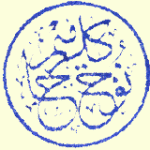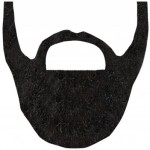-
On Keeping the Beard
By Sh. Nuh Keller
Categories : Fiqh
Dear Brother Isa Robert Martin:
Thank you for your letter of 10 August 1995 which read, in part:
. . . My question is not regarding the obligation to grow the beard and trim the mustache. This is clear from the statements of the Prophet (may Allah bless him and give him peace), the statements of the great Imams, and the practice of the early Muslims and righteous people up until the present day. My question is regarding the actual length of the beard, in which the beard must be grown. What did the great early Imams say regarding this specific matter? What is the position of the four madhhabs on this specific matter?
Ibn ‘Umar relates from the Prophet (Allah bless him and give him peace) that he said: “Do otherwise than those who ascribe partners to Allah (al-mushrikin): leave beards be, and trim mustaches.” And ibn ‘Umar, when he went on hajj or ‘umra, grasped his beard with his hand, and removed what was in excess of it (Sahih al-Bukhari. 9 vols. Cairo 1313/1895. Reprint (9 vols. in 3). Beirut: Dar al-Jil, n.d., 7.206: 5892 and Sahih Muslim, 5 vols. Cairo 1376/1956. Reprint. Beirut: Dar al-Fikr, 1403/1983, 1.222: 259).
In the Hanafi madhhab, there is no harm (la ba’s) in trimming the edges of the beard, though the handful is sunna, for when a narrator (Ibn ‘Umar, in this case), has done something in ostensive contravention to what he has narrated (the words “leave beards be”), Hanafi bases of jurisprudence say this shows that the narrator knows that the Prophet (Allah bless him and give him peace) has indicated that the original ruling has been superseded (mansukh) by a subsequent one–permitting the beard to be trimmed, in this case. But trimming it when it is already less than a handful is not permissible in the Hanafi school (Ibn ‘Abidin: Radd al-muhtar ‘ala al-durr al-mukhtar. 5 vols. Bulaq 1272/1855. Reprint. Beirut: Dar Ihya’ al-Turath al-‘Arabi, 1407/1987, 2.113).
Muhammad ibn Hasan al-Shaybani reports in Kitab al-athar, from Imam Abu Hanifa, that “the sunna concerning it [the beard] is the handful, and consists in a man grasping his beard with his hand, and whatever exceeds that, he cuts” (ibid, 5.261).
A Hanafi sheikh whom my wife and I study with, has told us (without mentioning a reference) that there is disagreement as to where this “handful” should begin from, some holding that one puts the index finger of it just below the lower lip, while according to others, one puts it below the bottom of the chin. The former will obviously result in a much shorter “handful.”
The Shafi’i scholar Imam Nawawi in his commentary on Sahih Muslim says of the above hadith:
As for trimming the mustache, it is also a sunna. It is praiseworthy to begin from the right side . . . . As for how much should be trimmed, the soundest position is that one trims it until the edge of the lip appears, not trimming it down to the roots. As for the versions of the hadith containing the words crop mustaches, (ihfu al-shawarib) they mean “crop that which grows over the lips,” and Allah knows best.
As for leave beards be, it means “make them ample” (Ar. tawfir, to make much, abundant, copious) and is also the meaning of make beards plenteous (awfu al-liha) in other versions of the hadith. It had been the Persians’ custom to cut their beards, so the Sacred Law forbade that (Sahih Muslim bi Sharh al-Nawawi. 18 vols. Cairo 1349/1930. Reprint (18 vols. in 9). Beirut: Dar al-Fikr, 1401/1981, 3.149).
Imam Baghawi records that “Malik has said, ‘Shaving the mustache is an innovation (bid’a) that has appeared among people'” (Sharh al-sunna. 16 vols. Damascus: al-Maktab al-Islami, 1400/1980, 12.108).
Ibn Daqiq al-‘Eid says: “I do not know anyone who has understood from the command to leave beards be that it is permissible to do them up so that they seem copious, as some people do” (Ibn Hajar al-‘Asqalani: Fath al-Bari bi sharh Sahih al-Bukhari. 14 vols. Cairo: al-Maktaba al-Salafiyya, 1390/1970, 10.351).
In his commentary on Sahih al-Bukhari, the great Hanafi hadith Imam Badr al-Din al-‘Ayni says:
If one objects: “What does ‘leave beards be’ mean, when ‘to leave be’ (al-i’fa’) literally means ‘to make plenteous,’ and there are people, who, if they were to leave their beard, following the outward sense of leave beards be, their beard would become outrageous in length and width, and look disgusting, so that the person would become a topic of conversation, or a proverb”–The reply is that it is established from the Prophet (Allah bless him and give him peace) that this hadith is conditioned by a specific context [i.e. the demand to do the contrary to what the Persians and non-Arabs did, established by the first words of the hadith], and that the amount and definition of the beard that is unlawful to leave uncut have been differed upon by the early Muslims . . . . The meaning, in my opinion, is “as long as it does not exceed what is customary among [religious] people.” ‘Ata’ [ibn Abi Rabah, Mufti of Mecca, d. 114/732), has said, “There is no harm in trimming a little from the length and sides of his beard, if it grows large and long, in order to avoid notoriety, or if one risks being made fun of” (‘Umda al-qari sharh Sahih al-Bukhari. 20 vols. Cairo: Mustafa Babi al-Halabi, 1392/1972, 18.76)
Imam Baghawi says: “‘Leaving the beard be’ means ‘making it ample’ (tawfiruha) . . . . It is related from Ibn ‘Umar that he used to grasp his beard with his whole hand, then remove what was in excess of that. This was also related from Abu Hurayra. Ibrahim [al-Nakha’i, d. 108/726] said, ‘They [the Sahaba] used to trim their beards on the sides'” (Sharh al-sunna, 12.1089).
For trimming the beard, one may adduce as evidence the hadith of ‘Umar ibn Harun, from Usama ibn Zayd, from ‘Amr ibn Shu’ayb, from his father, from his grandfather, that the Prophet (Allah bless him and give him peace) “used to trim from his beard, from its sides and its length” (Sunan al-Tirmidhi. 5 vols. Cairo n.d. Reprint. Beirut: Dar Ihya al-Turath al-‘Arabi, n.d., 5.94: 2762). The last narrator in the hadith’s chain of transmission, ‘Umar ibn Harun, is agreed-upon among most hadith Imams as being “fatally weak” (matruk) despite (or perhaps because of which) which, Tirmidhi mentions after citing the hadith that his own sheikh, Bukhari, had a good opinion of the narrator. The hadith perhaps remains weak, but Bukhari’s opinion carries its weight. My sheikh in Shafi’i fiqh, ‘Abd al-Wakil Durubi used to cite it, and I have not met a single shafi’i scholar (faqih) who did not trim his beard to considerably less than the-handful-below-the-chin length.
The following points can be inferred from all of the above, in answer to your question:
(1) The hadiths about “Leaving the beard be” are unconditional, that is, can be read to indicate that it is obligatory not to cut the beard at all.
(2) This ruling seems to be conditioned by a number of considerations from the actual practice of the Sahaba, who were trained by the Prophet (Allah bless him and give him peace) and intimately familiar with his appearance, such as:
(a) that Ibn ‘Umar, one of the most learned Sahaba and keenest in following the sunna, used to cut his beard when he went on hajj or ‘umra, that is, presumably in anticipation of entering the ihram or “state of pilgrim sanctity” in which it is unlawful for a Muslim to cut or otherwise remove any hairs of his beard, a situation in which a learned person could be expected to trim the maximum allowable, since he would be unable to to so (while in ihram) for some time to come. This shows that the unconditionality of the hadiths was, in Ibn ‘Umar’s view, conditioned by trimming the beard, in all probability by instruction or example of the Prophet (Allah bless him and give him peace), since the Sahaba were all legally upright (‘udul) by consensus (ijma’) of Muslim scholars, and it is inconceivable that they would institutionalize and set a precedent that was in direct defiance of a religious obligation.(b) Imam Baghawi reports that trimming the beard was also the practice of Abu Hurayra, another of the foremost scholars of the Sahaba, and Baghawi reports from Ibrahim al-Nakha’i, the sheikh of the early Muslim community in Iraq, that the Sahaba used to trim their beards on the sides.
(c) If the earliest Muslims had all had beards down to their waists or to their knees from never cutting them, this would have been conveyed to us by hadiths, but it has not.
(3) The wisdom of letting beards be, as in the above hadith of Bukhari and Muslim, is doing otherwise than the non-Muslims. Other hadiths, related in the Musannaf of Ibn Abi Shayba and other sources, explicitly state that the Persians used to shave their faces and grow their mustaches long. Distinguishing ourselves from them could be accomplished with considerably less than a long beard.
(4) General Islamic values entail beauty in behavior, manners, and dress. When a man once asked if liking fine clothes and sandals was a form of arrogance, the Prophet (Allah bless him and give him peace) said, “Verily, Allah is beautiful and loves beauty” (Sahih Muslim, 1.93: 91).
(5) The general Islamic demand for beauty entails refinement and moderation, at minimum meaning not to deliberately seek notoriety through one’s appearance. The Prophet of Islam (Allah bless him and give him peace) has said, “Whoever dresses in a garment of notoriety in this world, Allah will dress him in a garment of humiliation on Judgement Day” (Musnad al-Imam Ahmad. 6 vols. Cairo 1313/1895. Reprint. Beirut: Dar Sadir, n.d., 2.139), a well authenticated (hasan) hadith. One’s standards for this are not non-Muslims, however, as the Prophet (Allah bless him and give him peace) has said, “Whoever imitates a people is one of them” (Sunan Abi Dawud. 4 vols. Cairo n.d. Reprint (4 vols. in 2). Istanbul: al-Maktaba al-Islamiyya, n.d. 4.44: 4031). Rather, the standard is that of other religious Muslims.
(6) In consideration of these general values ((4) and (5)), Imam al-‘Ayni above investigates the length that obliges one to cut the beard, though he reports that the earliest authorities did not agree on this.
To summarize, to have a beard is obligatory for the Muslim man. The wording of the above sahih hadith indicates it should be abundant, though this is conditioned by the ‘urf or common acknowledgement for it among religious, practicing Muslims. The early Muslims trimmed their beards, and there is not an unequivocal text (nass) that establishes a fixed legal limit to length and size. While the sunna is considered by many ulama to be “the handful,” my own sheikhs trimmed their beards considerably closer than this, and they were ulama. It is my conviction and the premise of my approach to Islamic law that Allah will not punish the ordinary Muslim for something differed about between traditional ulama.
These considerations are particularly relevant to the circumstance that Islam has now spread to virtually every race on earth, and that genetically, not every man can grow a beard like Ibn ‘Umar’s. In my view, the differing capacities make preferable the more general fiqh criteria of (1) having a beard, (2) “abundance” according to one’s capacity, so it doesn’t look like the shaving of the non-Muslims, (3) and well-keptness that accords with the general Islamic standards of beauty (among people who are practicing Muslims) and avoidance of notoriety–rather than a certain mandatory length. And Allah knows best.
I remain at your service, sincerely,
Nuh Keller
October 1995








